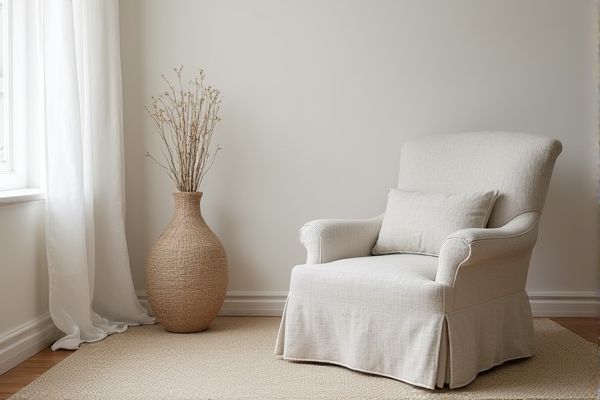
A slipcover chair offers protection and style versatility by easily adding fabric that can be changed or cleaned, while a bare chair showcases the original upholstery, emphasizing its design and material quality. Explore the rest of the article to discover which option best suits Your home decor and lifestyle needs.
Table of Comparison
| Feature | Slipcover Chair | Bare Chair |
|---|---|---|
| Protection | Provides fabric protection against stains and damage | Exposed to wear and potential damage |
| Maintenance | Easy to clean, removable and washable covers | Requires regular cleaning of upholstery |
| Appearance | Customizable look with changeable covers | Original design visible, less flexible style |
| Cost | Affordable additional investment for covers | Higher cost upfront with original upholstery |
| Durability | Slipcovers may wear out faster than structure | Upholstery integrity depends on material quality |
| Comfort | May slightly alter chair softness or fit | Direct contact with original cushioning |
| Style Flexibility | High - easy to switch covers seasonally | Low - fixed fabric and style |
Introduction to Slipcover Chairs vs Bare Chairs
Slipcover chairs offer a protective, customizable fabric cover that enhances durability and style, compared to bare chairs that expose the original upholstery to wear and tear. Slipcovers provide a versatile solution for easy cleaning, seasonal updates, and safeguarding against stains or pet hair, extending furniture lifespan. Bare chairs emphasize the natural design and material of the chair, appealing to minimalist aesthetics but requiring more maintenance to preserve appearance.
Aesthetic Differences: Style and Design
Slipcover chairs transform bare chairs by adding customizable fabric that introduces color, pattern, and texture to complement various interior styles, from modern to traditional. Bare chairs showcase the original material and design, emphasizing craftsmanship and natural finishes like wood or leather, which appeal to minimalist and rustic aesthetics. Slipcovers offer versatility for seasonal updates or decor changes, while bare chairs provide a consistent, timeless look that highlights the chair's structural design.
Comfort and Practicality
Slipcover chairs offer enhanced comfort with their soft, padded fabric that adapts to your body shape, providing a cozy seating experience compared to the firmer feel of bare chairs. Practicality is improved with slipcovers as they protect the chair from spills and stains, allowing for easy removal and cleaning, which extends the life of your furniture. Choosing a slipcover chair ensures your seating remains fresh and comfortable while simplifying upkeep in busy households or high-traffic areas.
Maintenance and Cleaning
Slipcover chairs offer greater ease of maintenance as their removable covers can be machine washed or replaced, protecting the underlying chair from stains and wear. Bare chairs, typically made of wood, leather, or upholstery, require regular spot cleaning, dusting, or professional cleaning to maintain their appearance and longevity. Choosing slipcovers can significantly extend the life of a chair while providing a versatile option for refreshing interior decor.
Durability and Longevity
Slipcover chairs offer enhanced durability by protecting the underlying fabric or material from stains, wear, and fading, extending the lifespan of the chair significantly. Bare chairs, exposed directly to daily use and environmental factors, can experience faster deterioration, especially in high-traffic areas. Investing in slipcovers made from high-quality, washable fabrics can increase longevity by allowing regular maintenance and easy replacement, preserving the chair's original structure.
Cost Comparison: Slipcover vs Bare
Slipcover chairs typically cost less upfront than bare chairs because slipcovers allow you to refresh outdated or worn furniture without purchasing a new piece. Bare chairs may have a higher initial price, reflecting their materials, craftsmanship, and design details. Your choice impacts long-term expenses, as slipcovers can be replaced or cleaned at a fraction of the cost of buying a completely new chair.
Versatility and Seasonal Changes
Slipcover chairs offer exceptional versatility by allowing easy updates to a room's aesthetic through interchangeable fabric covers that accommodate seasonal color schemes and patterns. Bare chairs, while showcasing the original upholstery's texture and design, limit adaptability and can become less visually appealing or functional as seasonal trends and practical needs change. Slipcovers also provide added protection during seasonal activities, preserving the chair's condition and extending its lifespan.
Protection Against Stains and Wear
Slipcover chairs provide superior protection against stains and wear by creating a removable barrier that shields the upholstery from spills, dirt, and daily use. Bare chairs, while visually appealing, expose the fabric or leather to direct contact, increasing the risk of permanent damage and fading over time. You can extend the life of your furniture and maintain its appearance longer by choosing slipcovers that are easy to clean and replace.
Environmental Impact and Sustainability
Slipcover chairs significantly reduce environmental impact by extending the life of existing furniture, minimizing the need for new manufacturing and waste generation. Bare chairs, especially those made with non-recyclable materials, contribute more to landfill accumulation and resource depletion over time. Choosing slipcovers supports sustainability by allowing you to refresh your furniture without contributing to excessive consumption and disposal.
Choosing the Best Option for Your Home
Slipcover chairs offer versatile style and protection, ideal for high-traffic areas or homes with pets and children, as their removable covers are easy to clean and update. Bare chairs highlight the natural beauty of upholstery and frame design, perfect for showcasing craftsmanship and providing a timeless aesthetic in formal or minimalist interiors. Selecting between slipcovered and bare chairs depends on lifestyle needs, maintenance preferences, and the desired balance between functionality and design impact.
 homyna.com
homyna.com